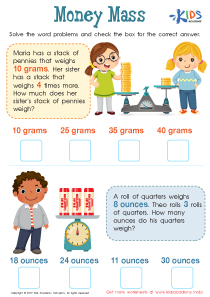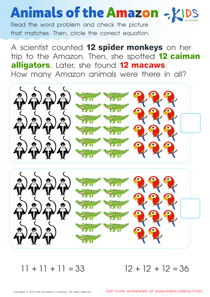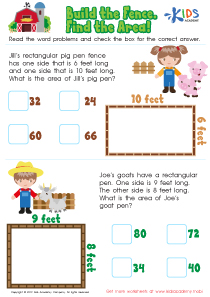Extra Challenge Length and Mass Word Problems Worksheets for 3-Year-Olds
1 filtered results
-
From - To
Introducing our Extra Challenge Length and Mass Word Problems worksheets, expertly crafted for three-year-olds embarking on their learning journey. These engaging homeschool homework sheets are designed to captivate young minds and introduce fundamental concepts of length and mass through simple, playful problems. Tailored specifically for little learners, these worksheets blend fun with education, ensuring your child grasps basic measurement concepts while enjoying their homeschool experience. Perfect for early education settings or at-home learning, these sheets provide a solid foundation in early math skills, encouraging curiosity and confidence in young problem solvers. Equip your child with the tools for academic success early on!


Length Word Problems Worksheet
The Value of Extra Challenge Worksheets on Length and Mass Word Problems for Three-Year-Olds
In the developmental journey of children, particularly those as young as three years old, incorporating effective educational tools is vital for fostering early academic skills. Learning worksheets, especially those focused on specific topics like Length and Mass Word Problems, play a crucial role in this developmental phase. These worksheets are not just sheets of paper; they are gateways to understanding basic mathematical concepts and real-world applications.
First and foremost, learning worksheets designed around the themes of length and mass help to introduce young learners to the fundamental ideas of measurement. At the age of three, children are just beginning to notice the world around them in more detail. They start to recognize differences in size, weight, and distance, making it the perfect time to formalize these observations into learning experiences. With worksheets tailored to their level, children can transform their natural curiosity into structured knowledge.
The utilization of Extra Challenge worksheets in topics like Length and Mass is particularly beneficial because these worksheets can be designed to incrementally increase in difficulty. This not only keeps the young minds engaged but also challenges them just enough to push their boundaries without causing frustration. For three-year-olds, these challenges might be simple tasks like choosing the heavier object between two or comparing the lengths of two items. Such exercises enhance critical thinking and decision-making skills from a tender age.
Moreover, these learning worksheets help in developing a child’s numerical literacy. Associating numbers with physical quantities like length and mass allows children to begin understanding the abstract concept of numbers as representations of real-world quantities. This early numeracy is pivotal as it lays the groundwork for more complex mathematical concepts that they will encounter as they progress in their educational journey.
Importantly, Length and Mass Word Problems worksheets are also tools for improving language skills. As children read or listen to the instructions and problems laid out in the worksheets, they learn new vocabulary related to measurement. Terms like "heavier," "lighter," "longer," and "shorter" become part of their everyday lexicon, enhancing their linguistic capabilities alongside their mathematical skills.
Furthermore, these worksheets provide an excellent opportunity for parents and educators to interact with the children. Guided engagement with the worksheets allows adults to explain concepts, answer questions, and provide encouragement. This interaction not only strengthens the learning process but also builds a supportive relationship where children feel valued and understood.
Lastly, the practicality of learning through worksheets cannot be overstated. They are a flexible resource that can be used in various settings, whether in a traditional classroom, at home, or even on the go. This adaptability makes it easier to integrate learning into daily routines, ensuring that children can learn consistently and effectively, regardless of their environment.
Incorporating Length and Mass Word Problems in learning worksheets for three-year-olds also prepares them for future educational settings. As they grow and transition into formal schooling, having been exposed to structured learning environments can ease their adaptation process. These worksheets teach them not only the content but also how to learn - focusing, following instructions, and completing tasks, which are essential skills for school readiness.
Additionally, the tactile interaction with the worksheets—writing, circling, or drawing—supports fine motor development. Handling pencils or crayons to circle heavier or longer items, for instance, refines their motor skills, which are crucial for writing, typing, and other physical activities later in life.
Furthermore, the satisfaction and confidence that children gain from successfully completing these worksheets are invaluable. Each completed worksheet provides a sense of accomplishment, boosting their self-esteem and motivating them to take on new challenges. This positive reinforcement is key to fostering a lifelong love of learning, encouraging them to remain curious and enthusiastic about discovering new information.
In conclusion, Extra Challenge worksheets on Length and Mass Word Problems are much more than simple educational tools; they are foundational instruments that shape early learning landscapes. For three-year-olds, these worksheets are not just about learning to measure or compare but about building a comprehensive skill set that includes cognitive, language, and motor skills, all while nurturing their intrinsic desire to explore and understand the world around them. By introducing these essential educational resources at an early age, we pave the way for well-rounded, confident learners ready to tackle the challenges of the future.
 Assign to My Students
Assign to My Students
















